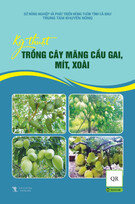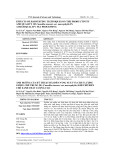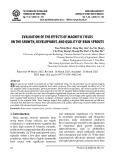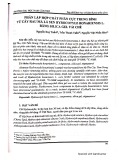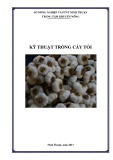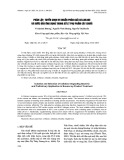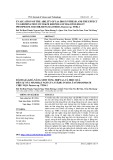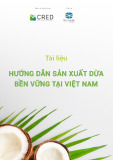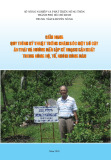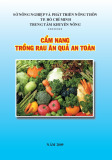250
JOURNAL OF SCIENCE AND TECHNOLOGY DONG NAI TECHNOLOGY UNIVERSITY
Special Issue APPLICATION OF ULTRASOUND TECHNIQUE IN THE EXTRACTION OF PROTEINS FROM CHICKPEA (CICER ARIETINUM L.)
Ho Thi Ngoc Nhung*, Nguyen Thi Thuy Duyen; Lai Thi Hien, Huynh Thi Thuy Loan, Phan Trong Than, Vu Tien Lam , Nguyen Bao Kha
Dong Nai Technology University *Corresponding author: Ho Thi Ngoc Nhung, hothingocnhung@dntu.edu.vn
GENERAL INFORMATION
Received date: 13/03/2024
to animal protein. The
Revised date: 17/05/2024
Accepted date: 20/07/2024
KEYWORD
Chickpea 1;
Protein 2;
Ultrasound 3;
ABSTRACT This study explores the potential of chickpea protein as a study nutritious alternative investigated the effects of water/powder ratio, ultrasound, and coagulation methods on chickpea protein recovery efficiency. The results showed that a water/powder ratio of 8/1 was optimal for protein extraction. In addition, when comparing the thermal precipitation method (60°C) and the acid precipitation method (5% acetic acid), the method of using heat was more efficient. Finally the study demonstrated that ultrasound, especially the Degas mode at 40Hz, significantly improved protein recovery with an efficiency of 43.76% and 43.05g of precipitated protein.
1. INTRODUCTION
of chickpea-derived
shown to
and various minerals
life, flavor, aroma, and nutritional shelf composition food products (Madurapperumage et al., 2021). Chickpeas had been lower cholesterol and blood sugar levels. Therefore, chickpeas can be included in a healthy diet to promote overall health and reduce the risk of cardiovascular diseases and diabetes (Rehm et al., 2023). (2.4%), with linolenic
Chickpea (Cicer arietinum L.) was a high- nutrient crop with a carbohydrate content (40– 60%), protein (15–22%), essential fats (4–8%), and vitamins (Madurapperumage et al., 2021; Hevryk et al., 2020). The fat composition includes palmitic (10.8%), oleic (33.5%), linoleic acid (49.7%), and antioxidant compounds tocopherols (230.3 mg/100g oil) and carotenoids (46.3 μg/100g flour) (Ferreira et al., 2019 ; Şengül et al., 2020). Moreover, chickpeas were rich in essential amino acids (Dutta et al., 2022) and had a low glycemic index, which helps regulate blood glucose levels (Kim et al., 2016). protein acids and
The growing global population has led to a growing demand for plant-based protein, with chickpeas emerging as a significant alternative protein source globally. From a nutritional these proteins had diverse perspective, biological activities, containing essential amino digestibility. Technologically, they were odorless, had a neutral flavor, and a suitable light color to be The fatty acid composition of the seeds enhances value, as fats impact the structure,
251
Special Issue
JOURNAL OF SCIENCE AND TECHNOLOGY DONG NAI TECHNOLOGY UNIVERSITY
regrind and filter the
precipitation, isoelectric
The determination of the water-to-bean ratio and chickpea protein recovery efficiency was performed as follows: accurately weigh the chickpeas, soak them for 2 hours with water-to-flour ratios of 6/1; 7/1; 8/1; 9/1. Then grind and filter the mixture, extract the milk solution, and discard the residue. During filtration, residue multiple times to extract all soluble substances in the milk solution. Boil the milk solution at 60°C until complete precipitation, continue to filter to collect the protein; and dry at 50°C to reach moisture equilibrium.
The protein content and protein recovery efficiency of the product were analyzed in this experiment.
Effect of precipitation method on protein lower the recovery: used as raw materials for developing new products such as noodles, bread, cookies, and sausages (Boukid et al., 2021). Chickpea protein has various functions, such as high solubility, good water and oil absorption, emulsification, foaming, gelation, and being rich in essential amino acids (Nkhata et al., 2014; Grasso et al., 2022). This protein can be extracted through dry or wet methods. A few basic dry and wet methods for increasing protein levels are alkaline/acid extraction, salt extraction, and membrane filtration (Boukid et al., 2021). The protein extraction method from chickpeas was studied from chickpea by isoelectric extraction method (Glusac et al., 2020). Investigate extraction strategies using current equipment for initial to regional used investment expenses.
applied was The method It was possible
to compare protein. After
protein precipitation using heat (60°C) and acid (5% the amount of acetic acid) recovered complete precipitation, continue filtering, recover the protein, and dry it at a temperature of 50°C to a constant weight.
The influence of ultrasound treatment on the protein recovery efficiency of chickpeas:
The samples experimental
to achieve protein precipitation through a variety of methods. One method involves using heat to induce protein precipitation (Lyu et al., 2021). You could also use mechanical methods to induce protein precipitation. The mechanical protein precipitation method used vortex flow to mechanically induce conformational change and protein precipitation (Lyu et al., 2021). In addition, studies also used acid protein extraction to recover proteins (Boukid et al., 2021). To support the extraction process better, researchers also used ultrasound during the protein extraction process (Ly et al., 2018).
2. METHODOLOGY
the milk then 2.1. Material
were sequentially treated with ultrasound in normal, soft, and degas modes at a frequency of 40Hz and with different waveforms (Fig. 2). We did not treat the control sample with ultrasound waves. The powdered beans were preliminary solution processed, and (chickpea milk) was boiled at 60°C combined with ultrasound until the solution completely precipitated, then filtered. The protein was collected and dried at 50°C to a constant weight. Chickpeas were purchased at Tan Hiep market, Bien Hoa City, Dong Nai Province and imported from Canada. It’s cleaned and checked worm in the laboratory of Dong Nai University of Technology before use. Method of data analysis and processing: 2.2. Methods
252
JOURNAL OF SCIENCE AND TECHNOLOGY DONG NAI TECHNOLOGY UNIVERSITY
Special Issue
the ammonia from to extract
The Kjeldahl method determined the total protein content. Use concentrated sulfuric acid to digest the sample, converting the nitrogen into ammonium sulfate. Utilize concentrated alkali the ammonium sulfate in the nitrogen distillation machine; this results in the formation of ammonium hydroxide, which then undergoes quantification using acid.
experimental results (Table 1) show that the amount of precipitate obtained with a water-to- flour ratio of 6:1 was only about 37.37g; increasing the amount of water increases the recovery rate of the precipitate, reaching 47.05g with a ratio of 8:1. Conversely, a ratio that was too high will reduce the viscosity of the mixture, but if the appropriate filter cloth was not selected during filtration, some material may be easily lost based on the amount of filtered water (a ratio of 9:1 - with 46.13g of precipitate obtained).
The moisture content of the sample was determined by drying to a constant weight at 105°C using an OHAUS-MB23 moisture balance.
Table 1. The difference in water/chickpea flour ratio affects the amount of protein obtained
Between-group variances were analyzed using one-way analysis of variance (ANOVA).
Ratio of water/chickpea flour
Amount of protein obtained (g)
Here's how to express the formula for
37.37c + 0.181
6/1
product recovery efficiency:
Protein recovery efficiency (%) = Amount
43.49b + 0.449
7/1
of protein obtained / Initial mass of substance
47.05a + 0.214
8/1
46.13a + 0.326
9/1
Amount of protein obtained: the mass of the product obtained after the production process.
Values in the same column followed by significant characters had a Initial mass of substance: volume of input the proceeding with different difference in meaning p = 0,05 before materials production process.
3. FINDINGS AND DISCUSSION
Table 2: The effect of water/chickpea meal ratio on protein recovery efficiency.
Ratio of water/chickpea flour
Recovery efficiency (%)
3.1. The influence of water-to- chickpea ratio on the recovery efficiency of chickpea protein
33.12b + 0.181
6/1
influencing the protein
38.4a + 0.449
7/1
39.84a + 0.214
8/1
38.3a + 0.326
9/1
The water-to-flour ratio was an important factor recovery efficiency of chickpeas. The proper water ratio helps the flour absorb water fully and quickly to reach a doughy state, creating favorable conditions for proteins and other water-soluble substances.
Values in the same column followed by significant characters had a
different difference in meaning p = 0,05 When the water-to-flour was too low, the chickpea milk mixture can become too thick, making it difficult to separate the protein. The
253
Special Issue
JOURNAL OF SCIENCE AND TECHNOLOGY DONG NAI TECHNOLOGY UNIVERSITY
In addition, the heat precipitation method was superior to the organic acid precipitation method not only in terms of the protein yield, low cost but also in that it does not take much time to implement and does not leave behind the sour odor of acid. Therefore, the heat method was suitable for precipitating chickpea protein.
Table 2 clearly shows that the water/flour ratio also influences the protein recovery efficiency of chickpea flour. Different water ratios will yield different protein amounts from the same amount of raw materials. The research results show that when adding water from the ratio of 6/1 - 8/1, the protein recovery efficiency increases from 33.12% to 39.84% and decreases to 18.3% when increasing the water amount to the ratio of 9/1. 3.3. The influence of ultrasound treatment on the recovery efficiency of chickpea protein
Therefore, the 8/1 water to soybean ratio was the most suitable for extracting chickpea protein for high protein recovery efficiency (39.84%) and high solid yield (47.05g).
3.2. The impact of the precipitation method on the protein recovery amount
and organic precipitation
The experiment surveyed 4 samples: treated with 40Hz normal, soft, degas ultrasonic waves, and heat samples not treated with ultrasonic waves. The experimental results show that changing the treatment mode (different waveforms at the same frequency) results in a significant difference in the amount of precipitate obtained. The precipitate amounts for the normal, soft, and degas samples were 35.36g, 39.22g, and 43.05g respectively, while the heat sample (using only heat and not treated with ultrasonic waves) yielded a significantly higher precipitate of over 47g (Figure. 2).
Carry out a survey of 2 experimental samples with 2 precipitation methods, namely heat acid precipitation. The experimental results show that with the heat precipitation method, the amount of precipitated protein was 49g, while using the organic acid precipitation method results in a lower amount of precipitate (32.93g) (Figure .1).
in
liquid with successive
The data in Figure. 1 shows a significant difference in the protein content of the product two different methods of when using precipitation. The protein content the corresponding product of the heat precipitation method and the acid precipitation method were 17.97g and 13.07g, respectively.
Although the yield of extract was the highest among the experimental samples, the protein recovery efficiency of the heat sample (38.23%) was lower than the ultrasound- treated degas sample (43.76%). Thwas was because the ultrasound waves transmitted into the cycles of compression and rarefaction had created gas bubbles, which burst under pressure and temperature, accelerating the protein diffusion process from the raw material and thereby increasing the protein extraction efficiency.
Therefore, the ultrasonic treatment method in degas mode combined with temperature achieved a high protein content recovery efficiency of 43.76%, making it the most suitable treatment for recovering protein from chickpea flour.
Figure .1. The influence of precipitation method on the amount of recovered protein
254
JOURNAL OF SCIENCE AND TECHNOLOGY DONG NAI TECHNOLOGY UNIVERSITY
Special Issue
Figure. 2. The influence of ultrasound treatment on the recovery efficiency of chickpea protein
4. CONCLUSION
nutrients for pregnant women. This research also opens up opportunities for studies related to the use of chicken peas as a source of high- quality and nutritious protein in the future.
REFERENCES in The study provides a positive outlook on the potential of chickpea protein as a nutrient- rich food source. The results show that the recovery efficiency of chickpea protein the research project reached obtained 43.76%.
The study determined a
Boukid, F. (2021). Chickpea (Cicer arietinum L.) protein as a prospective plant-based International review. ingredient: Journal of Food Science & Technology.
the extraction parameters of protein from chickpea seeds by adjusting the water/flour ratio at 8/1, using heat precipitation method at 60°C. These were important parameters to achieve high protein recovery efficiency.
Dutta, Trivedi, Nath, Gupta, Hazra (2022). A comprehensive review on grain legumes as climate-smart crops: challenges and prospects. Environ. Chall. 7, 100479.
The study also showed better temperature recovery of proteins when combined with the use of live ultrasound at the 40Hz degassing step.
Ferreira, et al., LWT (2019). Changes in the chemical composition and bioactive compounds of chickpea (Cicer arietinum L.) fortified by germination. 111: p. 363- 369.
With these results, we hope that the chickpea protein product can be further developed and widely applied in the food industry, contributing to improving human in providing essential health, especially
255
Special Issue
JOURNAL OF SCIENCE AND TECHNOLOGY DONG NAI TECHNOLOGY UNIVERSITY
Glusac, Isaschar-Ovdat, Fishman
follow-on formula. Nutrition journal 13: p. 8
(2020). Transglutaminase modifies the physical stability and digestibility of chickpea protein-stabilized oil-in-water emulsions, Food Chem. 315 126–301
ingredients: A 153 (5)
functionality,
Grasso, et al., (2022). Compr Rev Food Sci Food Saf, 21(1): p. 435-452. Chickpea review of protein composition, and applications Rehm, Goltz, Katcher, Guarneiri, Dicklin, Maki (2023). Trends and patterns of chickpea consumption among United States adults: analyses of national Health and nutrition examination survey data. J. 1567–1576, Nutr. https://doi.org/10.1016/J.TJNUT.2023.0 3.029.
Hevryk et al., (2020). Analysis of perspective for using chickpea seeds to produce functional food ingredients. Technology audit and production reserves,. 4: p. 41- 49. Şengül and Calislar (2020). Effect of partial replacement of soybean and corn with raw or processed chickpea. South African Journal Of Animal Science,. 50: p. 460-470.
Jiawen Lyu et al., (2021). Mechanical stress induced protein precipitation method for drug target screening, Analytica Chimica Acta , Vol. 1168, pp 338612-3386
Kim, Souza, Choo, Ha, Cozma, Chiavaroli, Sievenpiper (2016). Effects of dietary pulse consumption on body weight: a systematic review and meta-analysis of randomized controlled trials. Am. J. Clin. Nutr. 103 (5), 1213–1223.
Ly et al., (2018). Application of ultrasound to protein extraction from defatted rice bran. International Food Research Journa, 5(2): 695-701
Madurapperumage, A., et al,.
(2021). Chickpea (Cicer arietinum L.) as a Source of Essential Fatty Acids – A Biofortification Approach. Frontiers in Plant Science.
Nkhata, et al., (2014). The potential use of infant in development of chickpeas



